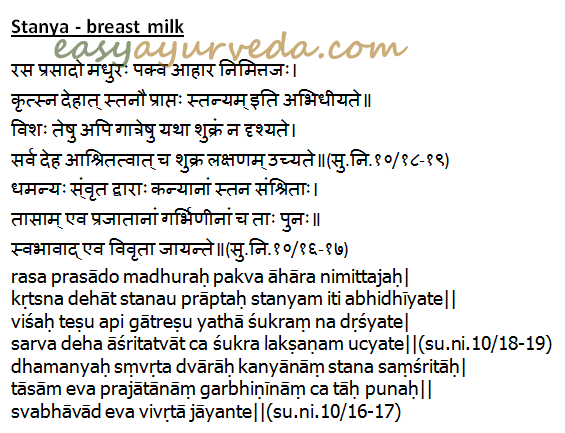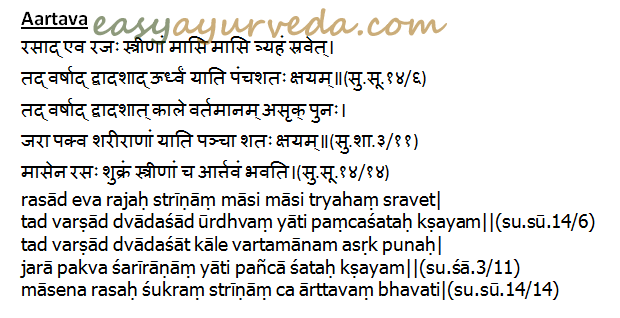Upadhatu Of Rasa Dhatu – Stanya, Arthava: Sub Tissues Of Rasa
Article by Dr Raghuram Y.S. MD (Ay) and Dr Manasa, B.A.M.S
Rasa dhatu is the essence of nutrition that circulates through the arteries. It is correlated with lymph, plasma or simply quoted as nutrition in circulation. Upadhatu or sub-tissues of Rasa dhatu are – Stanya (breast milk) and Artava (menstrual blood, ovum).
Stanya (breast milk)
Stanya is produced as an essence of the rasa (rasa dhatu) which again is produced from the pakwa ahara (digested food). It is spread all over the body (as is its parent tissue i.e. rasa dhatu, to which it is related) and on reaching the stanas (breasts) it will be called by the name ‘stanya’ or breast milk.

Just like Shukra (semen) which is spread all over the body in an invisible form and gets manifest and ejaculated during sexual intercourse, the stanya too exists all over the body in an invisible form but rushes to the stanas gaining the form of stanya when the mother wants to feed the child.
Read related: Upadhatus: Sub-Tissues Of The Body
Thus Stanya is said to have ‘Shukra Lakshana’ i.e. properties similar to Shukra. This also makes us understand that both these are available throughout the body, all time but are manifested only when there is a need or when factors like feeding reflex and love towards child, on touch, sight and thought of the child (stanya) and sexual urge and attraction towards woman while in sexual relation (shukra) are available.
Sushruta further tells that the ksheera dhamanis (milk carrying ducts or channels, lactiferous ducts) are shrinked in Kanyas (virgins, girl or woman who has not conceived) and will naturally be dilated and open in pregnant woman and in woman who has given birth to a child.
Aartava (menstrual fluid)

Aartava
The Raja or aartava is produced from the Rasa only in women and is manifested for 3 days once every month. Raja is produced after 12 years of age and ceases to appear (menopause after 50 years).
Rasa gets matured and processed over a period of one month and at the end of the month, the rasa gets converted into shukra (semen) in men and artava (menstrual blood, ovum) in women.
Rasa majorly nourishes Rakta dhatu and in quick time too, whereas the same rasa nourishes the raja or aartava in small proportions and in slow time. Therefore it takes one long month for the aartava to get properly nurtured and get manifested during monthly periods, while rakta dhatu is regularly produced.
Click to Consult Dr Raghuram Y.S. MD (Ayu)
Why male bodies are built stronger than female? What can be the Ayurvedic explanation for this?
Dr Hebbar
It is quite evident that the muscles, bones etc. in men are stronger than in women.
The food that we consume gets converted first into a nutritious fluid, called Rasa dhatu. This nutrition rich Rasa dhatu goes on to nourish all the other dhatus.
This Rasa dhatu has two sub-dhatus – they are
Stanya – breastmilk
and
Arthava – All hormones, fluids and components related to menstruation.
In women, the part of the nutrition gets diverted into creating organs, hormones and systems pertaining to menstruation and lactation. Ultimately this nutrition is passed on to the fetus, after conception.
In men, such a division of nutrition (Rasa Dhatu) into Upa dhatu is not there. The entirety of the nourishment from Rasa dhatu goes to the next tissue, that is blood, from there to muscle, then to fat, bones, marrow and reproductive tissues.
Because the entirety of the nutrition flows into all tissues in men, they have stronger bones and muscles.
Because some of the nutrition is utilized for preparing the reproductive system in women, their muscles, bones are comparatively weaker.
Because of the ability to bear the pains and discomforts of menstruation and childbirth, because they carry the more responsibility for the sustainment and growth of human civilization, women are mentally stronger and more organized than men.









2 comments
Prasanna
Sir I have confusion in assessment of shuddha stanya and dushita stanya where it is ? plz give information about this sir
Dr J V Hebbar MD(Ayu)Author
Hi, I do not have the references at hand. I will update it later.
Read related here
https://www.easyayurveda.com/2015/05/12/breast-milk-detoxification-dosha/
https://www.easyayurveda.com/2014/10/30/human-breast-milk-benefits-how-to-increase/